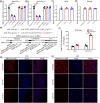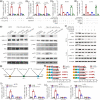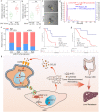Highly-metastatic colorectal cancer cell released miR-181a-5p-rich extracellular vesicles promote liver metastasis by activating hepatic stellate cells and remodelling the tumour microenvironment
- PMID: 35041299
- PMCID: PMC8765330
- DOI: 10.1002/jev2.12186
Highly-metastatic colorectal cancer cell released miR-181a-5p-rich extracellular vesicles promote liver metastasis by activating hepatic stellate cells and remodelling the tumour microenvironment
Abstract
Liver metastasis of colorectal cancer (CRLM) is the most common cause of CRC-related mortality, and is typically caused by interactions between CRC cells and the tumour microenvironment (TME) in the liver. However, the molecular mechanisms underlying the crosstalk between tumour-derived extracellular vesicle (EV) miRNAs and the TME in CRLM have yet to be fully elucidated. The present study demonstrated that highly metastatic CRC cells released more miR-181a-5p-rich EVs than cells which exhibit a low metastatic potential, in-turn promoting CRLM. Additionally, we verified that FUS mediated packaging of miR-181a-5p into CRC EVs, which in-turn persistently activated hepatic stellate cells (HSCs) by targeting SOCS3 and activating the IL6/STAT3 signalling pathway. Activated HSCs could secrete the chemokine CCL20 and further activate a CCL20/CCR6/ERK1/2/Elk-1/miR-181a-5p positive feedback loop, resulting in reprogramming of the TME and the formation of pre-metastatic niches in CRLM. Clinically, high levels of serum EV containing miR-181a-5p was positively correlated with liver metastasis in CRC patients. Taken together, highly metastatic CRC cells-derived EVs rich in miR-181a-5p could activate HSCs and remodel the TME, thereby facilitating liver metastasis in CRC patients. These results provide novel insight into the mechanism underlying liver metastasis in CRC.
Keywords: CCL20/CCR6/ERK1/2/Elk-1/miR-181a-5p feedback loop; colorectal liver metastasis; extracellular vesicle; hepatic stellate cell; miR-181a-5p; tumour microenvironment.
© 2022 The Authors. Journal of Extracellular Vesicles published by Wiley Periodicals, LLC on behalf of the International Society for Extracellular Vesicles.
Conflict of interest statement
The authors declare that they have no conflicts of interest.
Figures








References
-
- Ahmad, S. A. , Berman, R. S. , & Ellis, L. M. . (2003). Biology of colorectal liver metastases. Surgical Oncology Clinics of North America. 12, 135‐150. - PubMed
-
- Beckers, R. C. J. , Lambregts, D. M. J. , Lahaye, M. J. , Rao, S. ‐. X. , Kleinen, K. , Grootscholten, C. , Beets, G. L. , Beets‐Tan, R. G. H. , & Maas, M. . (2018). Advanced imaging to predict response to chemotherapy in colorectal liver metastases—A systematic review. HPB (Oxford). 20, 120–127. - PubMed
-
- Brenner, C. , Galluzzi, L. , Kepp, O. , & Kroemer, G. . (2013). Decoding cell death signals in liver inflammation. Journal of Hepatology. 59, 583‐594. - PubMed
-
- Chu, X. , Jin, Q. , Chen, H. , Wood, G. C. , Petrick, A. , Strodel, W. , Gabrielsen, J. , Benotti, P. , Mirshahi, T. , Carey, D. J. , Still, C. D. , Distefano, J. K. , & Gerhard, G. S. (2018). CCL20 is up‐regulated in non‐alcoholic fatty liver disease fibrosis and is produced by hepatic stellate cells in response to fatty acid loading. Journal of Translational Medicine. 16, 108. - PMC - PubMed
Publication types
MeSH terms
Substances
LinkOut - more resources
Full Text Sources
Medical
Molecular Biology Databases
Miscellaneous

